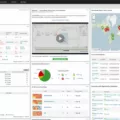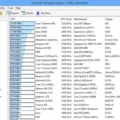As businesses adopt more and more advanced technologies, monitoring tools have become increasingly important. The ability to monitor systems and applications has become critical for keeping up with the ever-evolving IT landscape. One such monitoring tool is Zabbix, which is a feature-rich open-source platform for monitoring networks, servers, and applications.
While Zabbix is an excellent choice for monitoring many IT environments, there are some cases where an alternative might be better suited. For those looking for a Zabbix alternative, here’s a rundown of the top 5 contenders.
1. Netdata
Netdata is a free, open-source platform that provides comprehensive system and application performance metrics in real-time. It has an intuitive web interface that allows users to quickly identify performance issues and take appropriate action. It also includes alerting capabilities, so users can set thresholds for particular metrics and receive alerts when those thresholds are exceeded.
2. Nagios
Nagios is a reliable open-source monitoring tool that focuses on server availability, service uptime and resource utilization trends. It supports multiple operating systems and can provide detailed reports on system performance over time. It also offers custom plugins to extend its functionality even further.
3. Spiceworks
Spiceworks is a popular network management platform that helps organizations manage IT operations from one interface across multiple devices and operating systems including Windows, Mac OS X, and Linux distributions. Its features include system tracking & alerting, remote device management as well as powerful reporting capabilities.
4. LibreNMS
libreNMS is a powerful open-source network monitoring solution designed with scalability in mind – allowing it to monitor thousands of devices from one console without affecting the performance or reliability of the monitored systems themselves. LibreNMS provides granular data collection from various sources such as SNMP polling, WMI, IPMI, etc. Additionally, it includes powerful reporting capabilities.
5. Datadog
Datadog is a cloud-based infrastructure & application performance monitoring solution that provides detailed insights into your environment by analyzing large amounts of data collected from multiple sources. Additionally, it includes alerting capabilities so you can stay informed of any changes or potential issues that may arise. It also supports containerized environments such as Docker & Kubernetes.
With so many options available to choose from, it’s important to evaluate each one carefully before making your decision. However, whichever option you choose – you can rest assured knowing that you will have access to reliable, comprehensive data about your environment in real time – enabling you to make informed decisions quickly & efficiently.
Comparing Zabbix to Other Monitoring Solutions
Netdata is a great alternative to Zabbix, as it is both free and open source. It is a real-time monitoring system that provides an intuitive dashboard for visualizing and understanding the health of your infrastructure. Additionally, Netdata has an extensive library of plugins for collecting metrics from various sources, such as containers, servers, virtual machines, databases, and more. Nagios and Spiceworks are also good options for monitoring services, as they provide comprehensive coverage of services and devices. Similarly, LibreNMS and Datadog are error loggers that can detect potential errors or issues with your IT infrastructure before they become serious problems. Ultimately, the best alternative to Zabbix will depend on your specific needs and requirements.

Source: bestmonitoringtools.com
Comparing Nagios and Zabbix: Which Is Better?
When it comes to choosing a monitoring tool, it really depends on the individual needs and preferences of the user. Both Nagios and Zabbix have advantages and disadvantages. Nagios is an open-source tool with a wide range of features and customizability, however, it can be more difficult to learn and use than Zabbix. On the other hand, Zabbix is easier to set up and use than Nagios and has a more modern UI design. In terms of performance, Zabbix tends to be faster than Nagios, although both tools are reliable in their own right. Ultimately, it’s up to the user to decide which tool is better for their specific needs.
Comparing Prometheus and Zabbix
It is not possible to make a definitive statement as to which tool is better between Prometheus and Zabbix, as they are both robust time series monitoring tools with their own advantages. It depends on the specific requirements of the user.
Zabbix has been around longer and is a tried-and-true choice for monitoring, with a vast array of features. It provides a variety of alerting methods and can be used for performance tuning, problem detection, and capacity planning. However, it lacks some modern features such as cloud-native scalability and user-friendly dashboards.
On the other hand, Prometheus is a relatively new open-source tool that has become increasingly popular over recent years. It offers cloud-native scalability, advanced alerting capabilities, and easy-to-use dashboards which make it easier to monitor distributed systems in real-time. Additionally, its powerful query language makes it easier to identify trends in complex data sets.
In conclusion, both tools have strengths that make them suitable for different scenarios depending on the user’s needs.
Disadvantages of Zabbix
The main disadvantage of Zabbix is its lack of resilience. It has a single access point for users, which can be vulnerable to cyber-attacks or other malicious activities. Additionally, there is no way to differentiate access to data and configuration as all information is stored in the same database and managed through the same web interface. As Zabbix has a minimal interval between measurements of one second, it can cause a high load on the system and lead to performance issues. Furthermore, Zabbix does not support active-active clusters, meaning that if the active server fails, all monitoring processes will be stopped. Finally, due to its complexity, configuring and maintaining Zabbix can be challenging for novice users.

Source: accessorange.com
Comparing Grafana and Zabbix
Grafana and Zabbix are two open-source monitoring solutions that offer powerful capabilities. While they share some similarities, they are designed to address different needs.
Grafana is a visualization and analytics platform that enables users to quickly create, explore and share dashboards. It can integrate with a wide range of collectors, agents, and storage engines in order to provide real-time insights into the performance of your applications or infrastructure. Grafana’s data-driven approach allows you to quickly spot trends, anomalies, and opportunities for optimization.
On the other hand, Zabbix is an enterprise-grade monitoring solution that provides an all-in-one monitoring platform for IT services and applications. Zabbix is designed to detect problems as soon as they occur so that proactive measures can be taken before outages or performance issues occur. It offers various features such as alerting, notifications, logging, and reporting that help ensure uptime and performance optimization of your IT systems.
In conclusion, Grafana is great for visualizing data while Zabbix is better suited for proactively monitoring IT systems.
Is Zabbix Free?
Yes, Zabbix is completely free and can be used for commercial and non-commercial purposes. There are no restrictions on the number of devices that can be monitored with Zabbix, so it can be used to monitor thousands of devices at absolutely no cost.
Comparing Zabbix and Cacti: Which is Better?
The answer to this question depends on the specific needs of the user. Zabbix has a much broader approval than Cacti, being mentioned in many more company and developer stacks. However, both systems offer powerful monitoring and data analysis features.
When it comes to ease of use, Cacti may have an edge over Zabbix as it is often seen as simpler to use and configure, with a user-friendly interface. On the other hand, Zabbix offers more comprehensive monitoring tools, including real-time tracking of system performance and scalability. It also offers more advanced alerting options than Cacti does.
Ultimately, deciding which system is better for your needs will depend on the complexity of your environment and the specific metrics you need to track. Both solutions have their pros and cons and can be used for different purposes.
Is Nagios Free?
Yes, Nagios Core is free and open-source software. It can be freely downloaded and used to monitor systems, networks, and infrastructure. All of the features available in Nagios Core are available for free, with no restrictions or limitations. There is also an optional commercial version of Nagios called Nagios XI which is offered as a paid subscription service.
Comparing Nagios and Zabbix
Nagios and Zabbix are both open-source monitoring tools that help organizations monitor their IT infrastructure. However, there are several key differences between them.
Nagios is a server monitoring tool that is designed to detect outages and notify administrators when an issue arises. It monitors the availability of hosts and services on servers but does not provide detailed performance data. It is mainly used for basic health monitoring tasks such as uptime checks and alerting users of potential issues.
On the other hand, Zabbix is a large-scale distributed monitoring tool that can monitor any platform or device. It provides detailed performance data and provides more in-depth analysis than Nagios. It allows administrators to configure triggers based on performance metrics to detect anomalies or identify potential problems before they arise. Additionally, it can also be used for capacity planning, automation, and reporting purposes.
Differences Between Zabbix and CloudWatch
The main difference between Zabbix and CloudWatch is the type of software they are. CloudWatch is a native AWS monitoring tool, specifically designed to monitor the performance of their own services and resources. Zabbix is an open-source network performance monitoring software that allows users to monitor the performance of their entire IT infrastructure, including any cloud-based or on-premise services.
In terms of features, CloudWatch has more specific capabilities tailored to AWS services, such as real-time visibility into resource utilization and automated alarms that can be triggered based on certain criteria. It also offers metrics tracking and logging capabilities for applications running in AWS environments. Zabbix, on the other hand, provides more general network performance monitoring features such as server uptime and availability tracking, as well as alerting capabilities for any system change or unexpected event.
Ultimately, both Zabbix and CloudWatch can be used to ensure your systems are running smoothly and efficiently; which one you choose ultimately depends on your specific needs and requirements.

Source: servocode.com
Conclusion
In conclusion, there are many alternatives to the Zabbix monitoring tool, such as Netdata, Nagios, Spiceworks, LibreNMS, and Datadog. Each of these offers different advantages and disadvantages depending on the user’s needs. For example, Netdata is both free and open source, while Zabbix has great performance but lacks resilience. Prometheus is also a great tool for monitoring time series data, with both open-source and hosted options available. Ultimately, it is up to the user to decide which monitoring tool best meets their needs.








